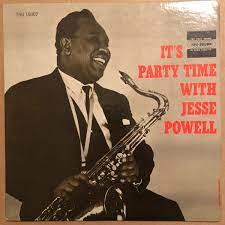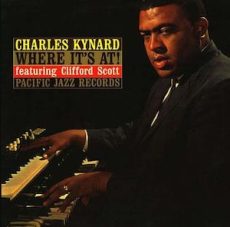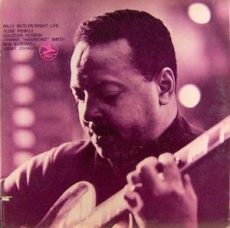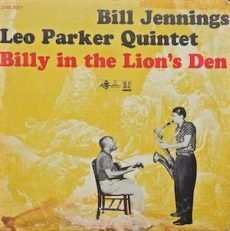
Daily Dose Of Jazz…
Jesse Powell was born in Smithville, Bastrop County, Texas, on February 27, 1924. He received his formal music training before he began his professional career at age eighteen, when he toured with fellow Texan, Oran “Hot Lips” Page beginning at the age of eighteen during 1942–43.
During the war years he went on to play with Louis Armstrong in 1943–44, then with the Luis Russell Orchestra in 1944–45. He replaced fellow Texas tenorist Illinois Jacquet in the Count Basie Band for a tour of California in 1946. At this time Powell also worked with blues singers Champion Jack Dupree and Brownie McGhee.
1947 saw Jesse joining Curly Russell’s band, and in 1948 he formed his own band in New York City. That same year he performed with trumpeter Howard McGhee at the first international jazz festival in Paris. In 1949–50, he was a member of the Dizzy Gillespie Big Band, with whom he recorded a solo on Tally Ho. In 1953 he once again formed another jump-rhythm band, and in 1964 a Powell quintet played at Birdland in New York City.
Tenor saxophonist Jesse Powell died on October 19, 1982 in New York City.
More Posts: bandleader,history,instrumental,jazz,music,saxophone

Daily Dose Of Jazz…
Charles Kynard was born in St. Louis, Missouri on February 20, 1933 and first played piano then switched to organ and led a trio in Kansas City. The trio included Tex Johnson on flute and saxophone, and Leroy Anderson on drums.
In 1963, he settled in Los Angeles, California and his band featured guitarists Cal Green and Ray Crawford, drummer Johnny Kirkwood. Between 1963 to 1973 Charles recorded ten albums as a leader, and ten albums as a sideman with Johnny Almond, Paul Jeffrey, Les McCann, Blue Mitchell, Howard Roberts, Clifford Scott, Sonny Stitt, and Tom Waits.
Organist Charles Kynard died on July 8, 1979.
More Posts: history,instrumental,jazz,music,organ

Daily Dose Of Jazz…
Lenny McBrowne was born Leonard Louis McBrowne in Brooklyn, New York on January 24, 1933. Influenced by his drummer father Arnold he took up drums at a young age, playing in street marching bands between ages 12 and 15, while also taking lessons on the bass. Graduating high school in 1951 he studied under Max Roach for one year and Sticks Evans.
McBrowne began his professional career in Pete Brown’s group, which featured Paul Bley. He also played with Randy Weston and Cecil Payne in various Brooklyn clubs, and with Paul Bley’s Trio in Montreal, Quebec, Canada. By 1956 he was playing with Tony Scott in New York City, and continued performing with Paul Bley in a college tour that led to his relocation to California.
His first West Coast dates included the likes of Billie Holiday, Sonny Stitt, Harold Land, Benny Golson, Curtis Fuller, Fred Katz and Sonny Rollins. 1959 saw Lenny forming his own group, The Four Souls, with pianist Terry Trotter, bassist Herbie Lewis, tenor saxophonist and composer Daniel Jackson, and trumpeter Donald Sleet.
Between January and March 1960, The band recorded their debut album Lenny McBrowne and the 4 Souls in 1960 that was released by Pacific Jazz Records. Shortly after they relocated to New York City and recorded their second and final album Eastern Lights with Jimmy Bond on bass. Cannonball Adderley was the producer and supervisor and the album was released by Riverside Records.
Described as a highly close-knit and well-rehearsed combo with fluid and competent soloing by several leading jazz magazines, the group was destined for dissolution. Lenny then free-lanced with Sal Salvador, Chris Connor and Carmen McRae. During the 1960s, he played with Sarah Vaughan, Lambert, Hendricks & Bavan, Randy Weston, Booker Ervin, Ray Bryant, Teddy Wilson, and toured Japan with Thelonious Monk.
In the second half of the 1960s, McBrowne played primarily with Ervin’s band. He then relocated to San Francisco, California and began to perform with Kenny Burrell on a regular basis until 1976, when he made his last recording. Hard bop and soul jazz drummer Lenny McBrowne transitioned on October 4, 1980 at 47 in San Francisco, California.
More Posts: bandleader,drums,history,instrumental,jazz,music

Daily Dose Of Jazz…
Billy Butler was born William Butler Jr. on December 15, 1924 in Philadelphia, Pennsylvania and began his career in the 1940s behind the Harlemaires. The 1950s saw him as a member of a trio led by Doc Bagby and accompanied keyboardist Bill Doggett.
Butler worked with Al Casey, King Curtis, Eddie “Lockjaw” Davis, Bill Davison, Tommy Flanagan, Panama Francis, Dizzy Gillespie, Benny Goodman, Johnny Hodges, Floyd “Candy” Johnson, David “Fathead” Newman, Houston Person, Sammy Price, Jimmy Smith, Norris Turney, and Dinah Washington.
He is credited as the guitarist on the 1961 Peppermint Twist, Parts 1 & 2 by Joey Dee and the Starliters at the Peppermint Lounge in New York City. He co-wrote Honky Tonk, an R&B hit for Doggett.
Guitarist Billy Butler transitioned on March 20, 1991 from a heart attack at home in Teaneck, New Jersey.
More Posts: bandleader,guitar,history,instrumental,jazz,music

Daily Dose Of Jazz…
Bill Jennings was born September 12, 1919 in Indianapolis, Indiana and started out with his twin brother, Albert, in a trio called The Three Spades. He would later work with Louis Jordan and his Tympany Five, Wild Bill Davis Trio, Jack McDuff, Willis “Gator” Jackson, Bill Doggett, Louis Armstrong, Chris Powell And His Five Blue Flames, Hot Lips Page and others.
Recording as both a leader and a sideman, Bill has influenced numerous musicians in the genres of jazz, soul, R&B, and blues guitar. B.B. King often mentioned Jennings as one of his biggest influences. He recorded with such artists as Leo Parker, King Curtis, Ella Fitzgerald, Jerry Daniels of the Inkspots, Kenny Burrell, Betty Roche and Stuff Smith.
His unique ability to play in many styles included swing, bop, jump blues, R&B, and pop. Jennings played on Fever by Little Willie John, which made the Billboard R&B chart in the U.S. and peaked at number 24 on the Billboard Hot 100.
A left-handed player, Bill played guitar upside down, with the high strings at the top, which gave him a different approach to phrasing and bending the strings. Later in his career, he lost a finger on his fretting hand and began playing bass guitar.
Guitarist and composer Bill Jennings, who was described as “The Architect Of Soul Jazz”, transitioned at Veterans Hospital in Indianapolis on November 29, 1978 at the age of 59.
More Posts: bandleader,composer,guitar,history,instrumental,jazz,music





